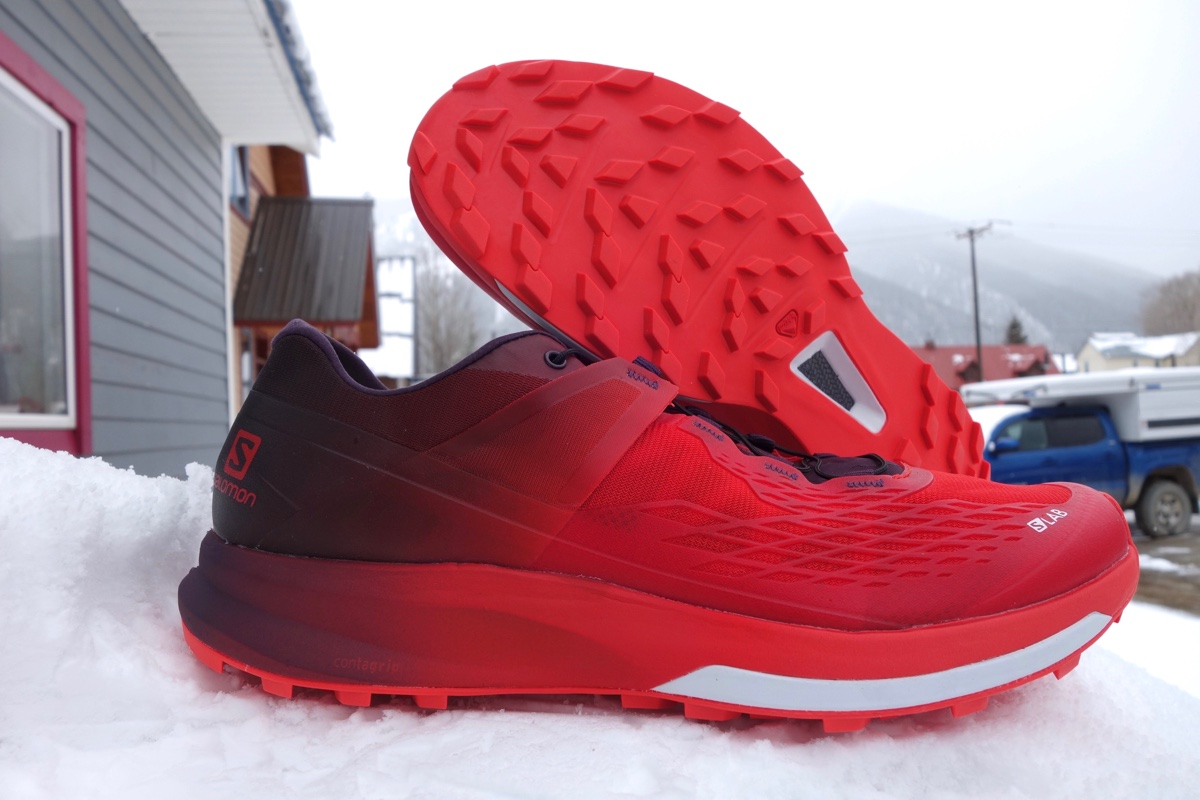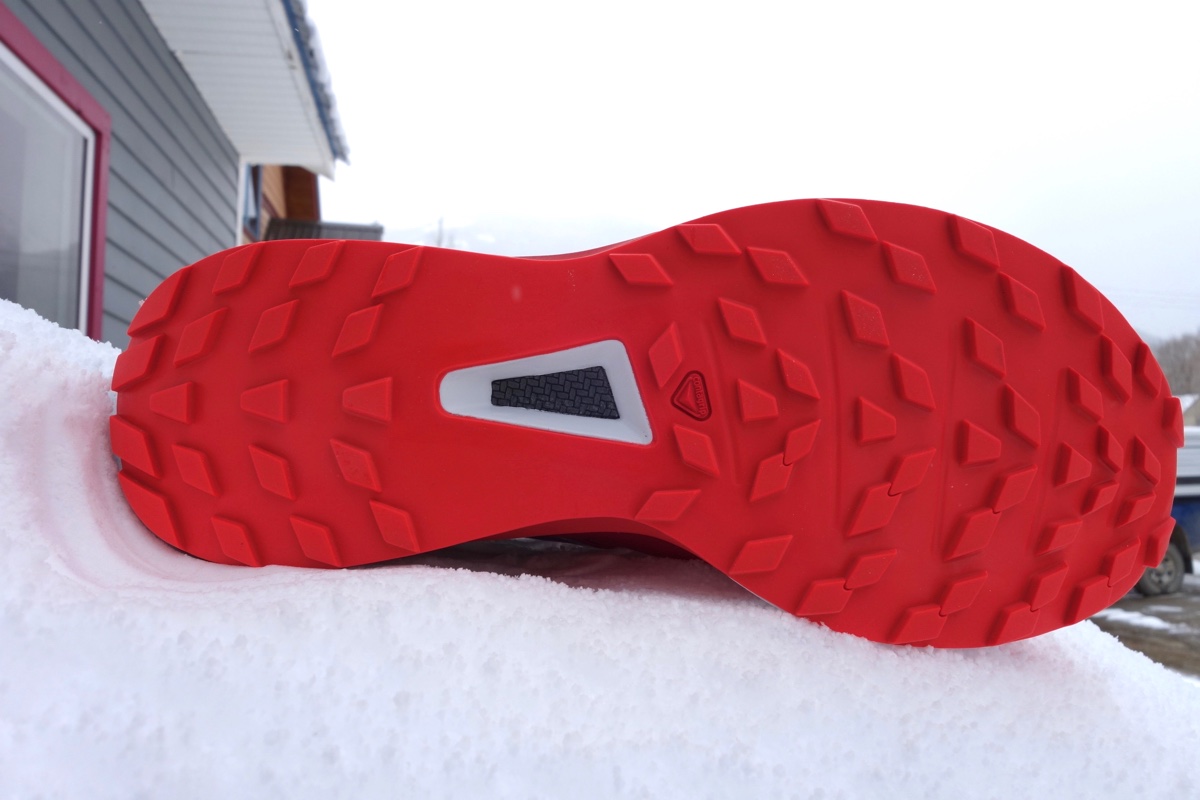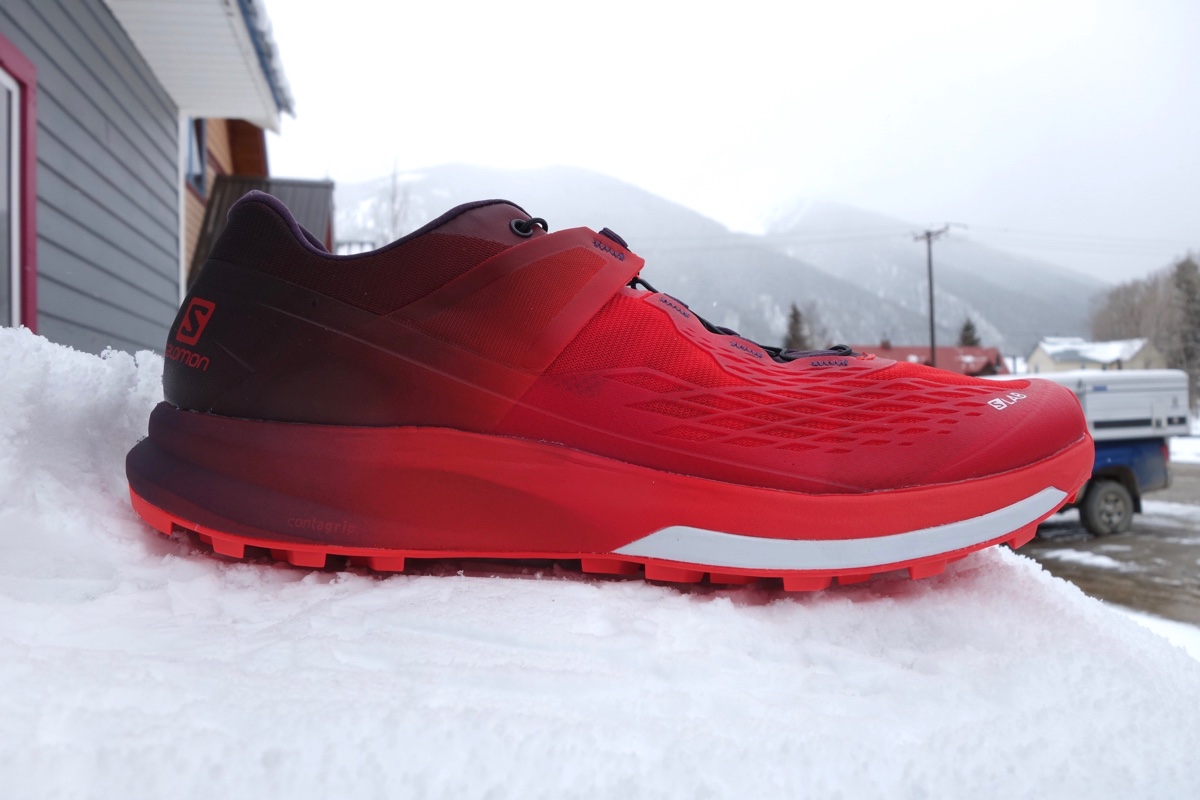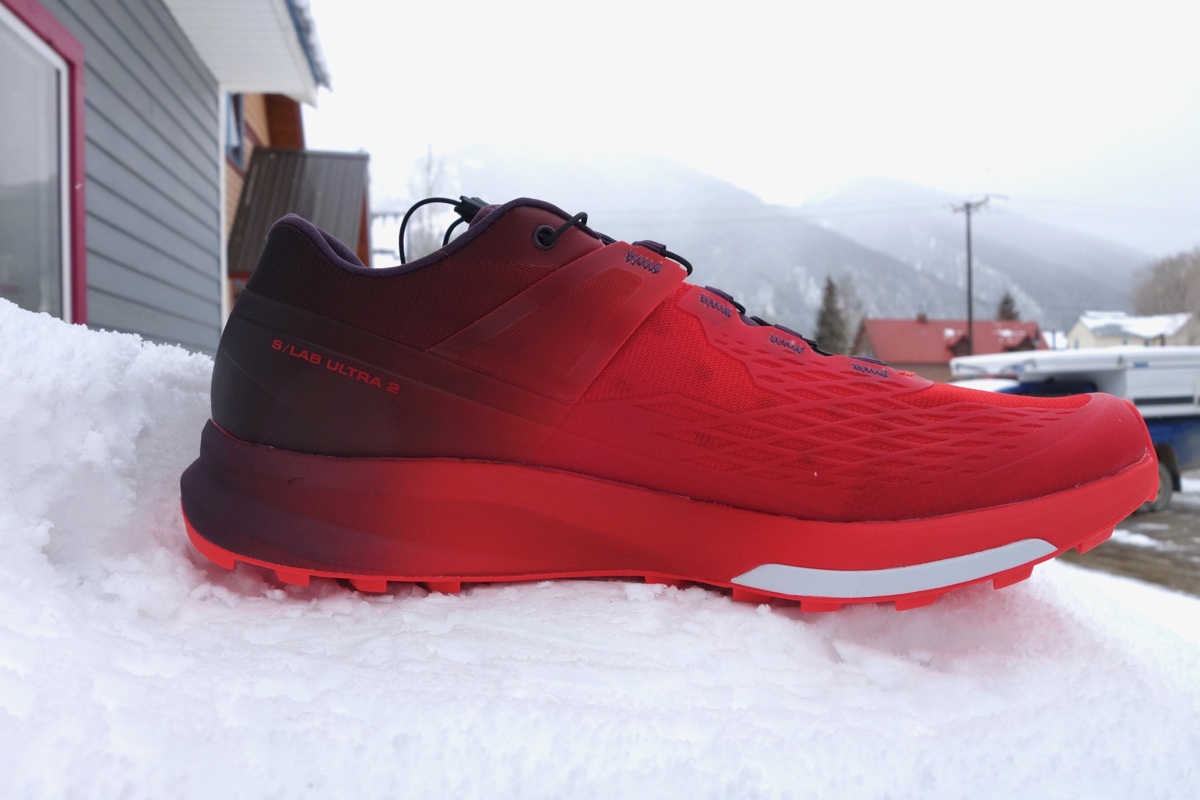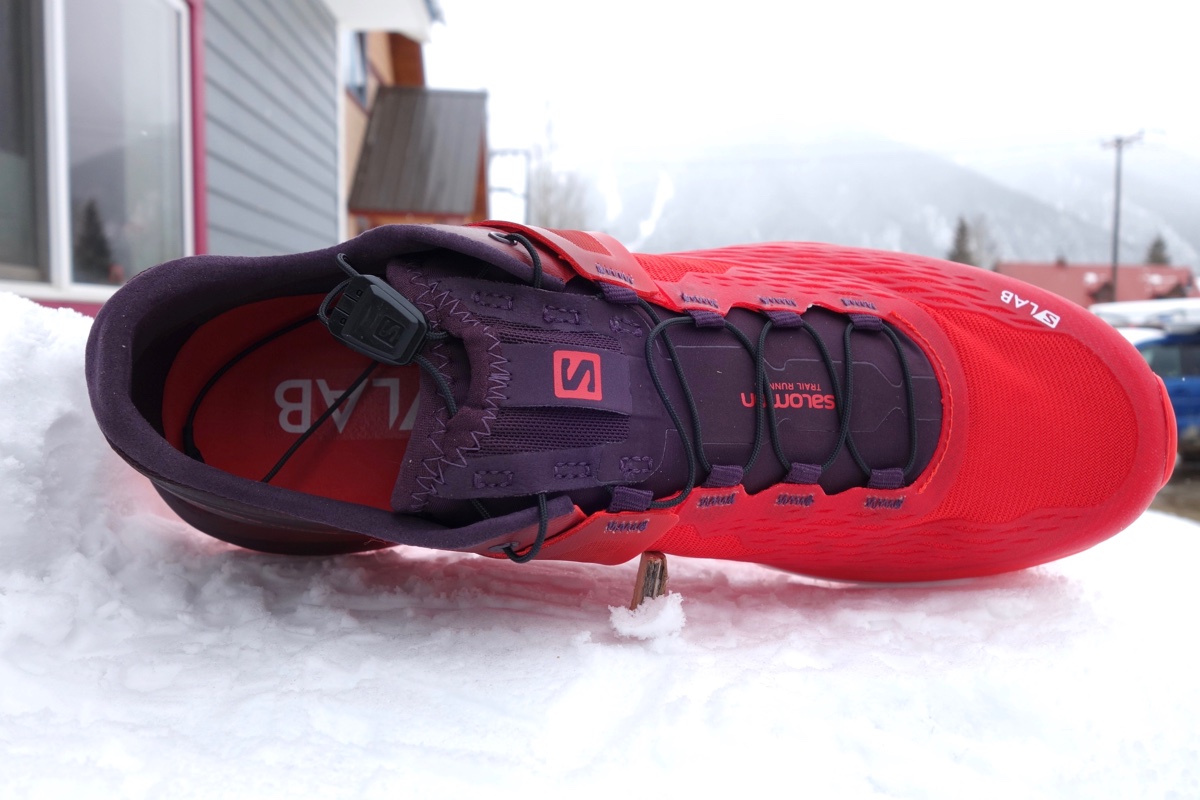For the latest on the Salomon S/Lab Ultra, you can read our Salomon S/Lab Ultra 3 v2 review.
Our Favorite Trail Running Shoes
Check out our Best Trail Running Shoes article to learn about our current favorite trail running shoes!
Salomon S/Lab Ultra 2 Review
Salomon gear holds a special place in my heart. There’s just something about the brand that makes me want to use it. Salomon makes shorts, packs, shirts, water bottles, shoes, and other items that are specific to trail running and ultrarunning. Pair that with their stable of top athletes and inspiring videos, and it is easy to see why Salomon has such a high profile in our niche community. So when they drop an update to a shoe focused specifically on the ultrarunning crowd, I want to see what it is all about. The Salomon S/LAB Ultra 2 ($180) weighs in around 10 ounces, has an 8mm drop, and features a unique color way representing sun up to sun down. In this video review, we go in depth to show off its features and discuss how this shoe performs.
Salomon S/LAB Ultra 2 Review Transcript
Welcome to Trail Trials, the video-review section of iRunFar. My name is Travis Liles and in this video we’re taking a look at the Salomon S/Lab Ultra 2.
As its name states, this is the second version of the S/Lab Ultra. It weighs 285 grams (10 ounces) in a men’s size 9. It’s a unisex shoe, which means that if you want to go out and grab the women’s weight–I couldn’t find it. I looked on Salomon’s website and other websites. It would be less than 285g (10 oz). There’s an 8mm drop from heel to toe. The sole measures 26mm at the heel and 18mm at the toe.
This shoe is directed mainly at the ultrarunning crowd, which I find interesting because this is another shoe from a major trail running brand that is focusing on that subsegment of the market. The shoe is part of Salomon’s S/Lab line, which is the highest caliber in terms of their materials and research and development. It’s what all of their major, professional athletes wear. In fact, this one was designed in conjunction with François D’haene, a major mountain athlete.
Even the colors of this shoe are about long distance and wearing it for a long time. That’s what the faded look is [the shoe is red at the toebox and fades to black at the heel]. It’s day to night, or night to day: that’s what they’re trying to convey with this color way. This is a shoe that you can wear for a long time for long adventures.
With those things in mind, let’s get up close and personal and see what this shoe is all about.
Salomon S/LAB Ultra 2 Outsole
Let’s start off by looking at the tread. This shoe uses what’s known as the Contagrip MA compound. This compound is meant to cover a wide variety of terrain and distances. It’s designed for durability and to be the best of everything. What I found in my testing is that the outsole is a little bit sticky, a little bit soft, and a little bit rigid. It’s supposed to hold up over time, and so far I don’t see a lot of wear patterns from it. It’s supposed to work across a lot of different terrain types. That’s done by being this middle-of-the-ground compound. It’s not really focused or specific to anything.
The lugs aren’t really deep; they’re sort of shallow but there are a lot of them. Whether you’re in a long-distance race or adventure, you’re going to encounter rocks, roots, mud, gravel, streets, pavement, a whole lot of stuff. This is a tread pattern and lug depth that work well in a lot of different scenarios, with a compound that’s supposed to hold up over a long amount of time. In my time of testing the shoe, I haven’t seen a lot of breakdown or anything anomalous.
If you’re a Salomon user, you’re probably noticing some pretty common things [with this outsole], lots and lots of lugs with this bladed look. In the back we have the reverse lugs, for braking and going downhill. Up front you’ll see the lugs are pointed and meant for climbing. They provide traction when you’re going uphill.
In the middle, you probably noticed this window that looks into the midsole. What we have here is Profeel Film–try saying that one twice. Profeel Film is a rock plate, sandwiched in the midsole. It’s not hard and a traditional plastic like a lot of rock plates you see. In fact, if you push your finger on it, you will feel it bend in there a little bit, and that’s the point. The idea is that it deflects obstacles as they poke into the bottom of it. A lot of times, a rock plate is a large, hard piece of plastic that sits there [gestures under the forefoot and midfoot]. The downside of that is when you land on things, you’re sort of forced to rock one way or the other [mimics the movement of a foot tilting at the ankle] because it doesn’t have a lot of give. This Profeel Film is meant to kind of absorb [a rock], deflect it, and push it away without being a really hard impact. You’re less likely to roll an ankle, slip, or fall because it’s not quite as aggressive a movement.
You’re going to have some feel to the ground. Even though this is an ultra shoe, this is not a max-cushion shoe and it doesn’t have a hard rock plate. You have a little ground feel. It will be muted, but it’s not a tank-like shoe where you can’t even feel what’s underneath you.
Salomon S/LAB Ultra 2 Midsole
As we move onto the midsole, what you’ll notice is a pretty standard foam all around. You won’t see any blocks or breaking or anything that’s meant for pronation control. That’s not really in here–it’s very much a neutral shoe. This is the Energy Cell+ foam. The intent of this midsole is to be a general-purpose foam that works for a lot of things. Again, it’s designed for long distance, so the midsole is designed for comfort and durability.
Salomon is really pushing the idea of [the shoe being intended for] ultras. It’s not a max-cushioned shoe, but in terms of Salomon’s world, this is a thicker-cushioned midsole than you’re going to find on a lot of the S/Lab stuff. A lot of the S/Lab stuff is luggier or designed for a specific kind of event, whether it’s muddy terrain or VKs [vertical kilometers] where you want speed and a precise fit. This shoe is meant more for that middle ground. If I was to classify this midsole, this is more of a classic type of midsole. It’s not really thin, and it’s not overly thick. It’s that standard type of midsole in terms of impact and cushioning and it does well in a lot of scenarios.
I wore this on some really rocky stuff. And my first 20 miles on these shoes was actually road running and they felt good, they transitioned well. The midsole is a little firmer than a Hoka One One shoe, or if you’re used to something with a lot of squish to it. This is a more responsive type of midsole. Even though it’s cushier than some of the other S/Lab models, you’re still looking at a slightly firmer, speedier feel when you’re running in these. Depending on your style, that could be exactly what you’re looking for.
Salomon S/LAB Ultra 2 Upper
Moving on to the upper, it starts with EndoFit. The EndoFit is a bootie-type construction, almost like a slipper. If you look inside the shoe, you’ll see a black [piece] down in the corners. From the top eyelet down to the bottom eyelet, this is all one [piece] wrapped inside of the shoe. The tongue is attached to a bit of a gusset on the inside. That gusset extends down all the way to the midsole. It wraps itself around and is on the other side of the midsole as well. When you slide in, one of the first things you notice is that it’s a really good fit in terms of hugging your foot and it feels sock-like. Because of that and the lack of stitching, there aren’t a lot of hot spots to be had on the inside from rubbing. Your foot really is protected inside the shoe.
Here along the sides is what’s known as the Skin Guard. The Skin Guard is this TPU (thermoplastic polyurethane)-injected mesh. You can see this spiderweb all along the sides, both medial and lateral. This is meant for reinforcement of the [upper]. Instead of being just for a straight-up mesh design, this is meant for durability in high-abrasion areas. I would say it also adds some support to your foot. When you’re moving laterally, you don’t feel like you’re blowing out of the side of your shoe, which can happen sometimes in the more all-mesh types of shoes.
Moving onto the front, you’ll notice this toe bumper. Salomon continued this TPU [along the sides of the shoe] and thickened it up along the sides to a toe bumper, and that’s where the outsole comes up and connects at the front for a fairly good toe bumper. Again, it’s not a bomb-proof tank shoe, but it has enough protection to protect you from those big hits and bumping and kicking of things.
As we move our way to the back, you’ll notice that the mesh really starts to disappear and it starts to be a lot of this molded, TPU kind of rubbery material. That’s what makes up the entire heel cup. This heel cup is really interesting because there’s not a hard piece of plastic in there [demonstrates by squishing the heel of the shoe downward with one hand]. It’s really easy to fold down, but it keeps its structure from these TPU overlays.
One of the things I was not sure about when I put this shoe on was this aspect. I wasn’t sure how well it was going to be able to hold my foot in, but it does a really awesome job. It almost feels like it suction cups to the back of my heel. Depending on the heel, your results may vary. It fits the heel very well; it’s soft at the top of the heel cup. Going downhill, I didn’t feel like there was a bunch of pressure on my Achilles tendon. Because the heel cup is flexible yet sticky, it felt like it moved with my heel really well.
Moving up here to the laces, this is the classic Salomon Quicklace fit. You’ve got your lace; it’s one, big piece of lace that runs throughout the shoe. The eyelets are made of fabric–there’s nothing hard or plastic. It’s all very soft and pliable materials throughout. You get the shoe on and it has a nice, bootie-like feel. You’ve got the heel grip, you pull the lace tight, and it should hopefully cinch your foot down.
One of the things I was worried about was that because of this Quicklace system, you can’t really adjust your shoelaces up one more notch. You’re stuck with what this is, but with the heel cup along with this upper, it actually does a really awesome job of locking your foot in.
When you look slightly further forward, you see these wings that are meant to keep the upper part of your midfoot in place. This is a really sticky shoe. What I mean by that is when you put your foot in it, it feels fast and it grips. It’s able to manage hitting tough turns and downhills really quite well. If you are a previous owner of the S/Lab Ultra, what you’ll note is that one of the pairs of wings was removed [gestures toward the front of the shoe, near the bottom eyelets]. It seems there were complaints online that those were adding some restrictions in the upper. So, to give a little bit more space, Salomon removed those [second] wings and only kept the ones at the top. I would probably say that’s beneficial to more runners because this is a narrow-fitting shoe.
If you look at the shoe, it’s streamlined. If you look at the bottom, it’s not like a platform. It’s got a fairly narrow toebox and a fairly low-volume toebox as well. This is one of those things where, I would say, it’s built for speed more than comfort. You can get both, of course, it’s always going to depend on your foot type. This is definitely a slim-fit shoe.
The last thing I’ll call out on the upper is the Quicklace garage. You put the shoe on, you lace it up, and you slide the lace lock directly into the garage and it keeps them from getting snagged.
Salomon S/LAB Ultra 2 Overall Impressions
I have a couple of dislikes. One is that it’s a pretty narrow fit. Because of that, you have a low toebox; it’s a little bit narrow. The shoe itself is a little bit narrow–it’s considered a slim-fit shoe. Depending on your foot type, this just may not work for you. It could also depend on how much your foot swells over the course of an adventure. That may be something to look out for.
Another thing is that the shoe is long. What I mean by that is, I wear a size 9 in just about everything. This [gestures to the shoe he’s holding] is a 9 and I feel like a size 8.75 would be about right, but an 8.5 would be too small. Maybe it’s the unisex sizing, I’m not sure. For me, this shoe is just a little bit long but I don’t think I could do anything different because it has a low toebox and it is a little bit narrow. If I pushed my foot back more, I just don’t think I’d have enough room for my toes to wiggle.
Quickly, the laces, I just don’t feel like I have the ability to dial in the fit the exact way that I want. And the sock liner, this insole got wet and it curled up under my foot as I was descending down a steep hill [pulls it out of the shoe and tosses it over his shoulder]. That’s not great. You can glue it in with some shoe glue; I’ve done that on other trail running shoes in the past and it works fine. It’s just annoying.
Lastly, the outsole, it works pretty well in most cases, but one place I found where it’s not so great is on really slick stuff. I’m here in Portland[, Oregon], out in the [U.S.] Pacific Northwest. Stuff gets slimy and mossy, and these things slide. There were even times where I was running on a road or a sidewalk and if it was a smooth, wet sort of area, these shoes had a little bit of slide to them that was not super-confident feeling.
Let’s look at what I do like. Well, secure fit, when you put this thing on, you feel ready to go. It’s a shoe you put on and you go, “Yep, I can run fast in this.” It’s got a smooth ride on trails and roads. I’ve worn this for a bunch of road running and trail running and it works really well on both. You feel confident and fast. When you’re on pavement, it doesn’t feel slappy or out of place. It just works for a lot of different cases.
Lastly, it looks cool. That’s a preference of mine. Not all trail shoes do. Maybe they’re really tall or they’re really bulky looking; they’re not great for just wearing around after you’ve retired them to your closet.
Read up on more new trail shoes for fall-winter 2019.
Call for Comments
So with that, questions? Comments? Thoughts of your own? Leave them below this video. Thanks for watching and we’ll catch you next time.
[Editor’s Note: If you’re affiliated (i.e., an employee, ambassador, etc.) with a shoe brand, please share your relation in each of your comments on this article. Thanks!]
